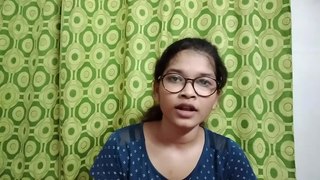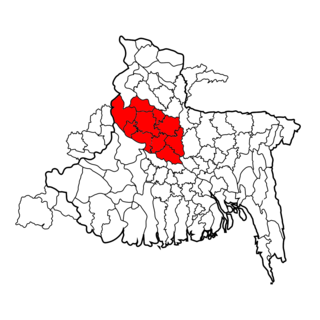Related Research Articles

Assamese, also Asamiya, is an Indo-Aryan language spoken mainly in the northeast Indian state of Assam, where it is an official language. It is the easternmost Indo-Iranian language, spoken by over 23 million speakers, and serves as lingua franca of the region.

"Amar Sonar Bangla" is the national anthem of Bangladesh. An ode to Mother Bengal, the lyrics were written by Bengali polymath Rabindranath Tagore in 1905, while the melody of the hymn was adopted from the Baul singer Gagan Harkara's song "Ami Kothay Pabo Tare" set to Dadra Tala. The modern instrumental rendition was arranged by Bangladeshi musician Samar Das.

Sylheti is an Indo-Aryan language spoken by an estimated 11 million people, primarily in the Sylhet Division of Bangladesh, the Barak Valley and Hojai district of Assam, and North Tripura and Unakoti district of Tripura, India. Besides, there are substantial numbers of Sylheti speakers in the Indian states of Meghalaya, Manipur and Nagaland as well as diaspora communities in the United Kingdom, the United States, Canada and the Middle East.

Santali, also known as Santal, is the most widely spoken language of the Munda subfamily of the Austroasiatic languages, related to Ho and Mundari, spoken mainly in the Indian states of Assam, Bihar, Jharkhand, Mizoram, Odisha, Tripura and West Bengal. It is a recognised regional language of India per the Eighth Schedule of the Indian Constitution. It is spoken by around 7.6 million people in India, Bangladesh, Bhutan and Nepal, making it the third most-spoken Austroasiatic language after Vietnamese and Khmer.

Akkala Sámi was a Sámi language spoken in the Sámi villages of A´kkel, Ču´kksuâl and Sââ´rvesjäu´rr, in the inland parts of the Kola Peninsula in Russia. Formerly erroneously regarded as a dialect of Kildin Sámi, it has recently become recognized as an independent Sámi language that is most closely related to its western neighbor Skolt Sámi.
Huave is a language isolate spoken by the indigenous Huave people on the Pacific coast of the Mexican state of Oaxaca. The language is spoken in four villages on the Isthmus of Tehuantepec, in the southeast of the state, by around 20,000 people.

The dialects of the Bengali language are part of the Eastern Indo-Aryan language group of the Indo-European language family widely spoken in the Bengal region of South Asia. The spoken dialects of Bengali are mutually intelligible with neighbouring dialects.
The phonology of Bengali, like that of its neighbouring Eastern Indo-Aryan languages, is characterised by a wide variety of diphthongs and inherent back vowels.

Hajong is an Indo-Aryan language with a possible Tibeto-Burman language substratum. It is spoken by approximately 80,000 ethnic Hajongs across the northeast of the Indian subcontinent, specifically in the states of Assam, Meghalaya, Arunachal Pradesh, and West Bengal in present-day India, and the divisions of Mymensingh and Sylhet in present-day Bangladesh. It is written in Bengali-Assamese script and Latin script. It has many Sanskrit loanwords. The Hajongs originally spoke a Tibeto-Burman language, but it later mixed with Assamese and Bengali.

The national language and official language of Bangladesh is Bengali according to the third article of the Constitution of Bangladesh. The second most spoken language in Bangladesh is claimed to be Burmese which is spoken by the Marma tribe in Chittagong Hill districts as the districts border Myanmar and it's also spoken by the Rohingya people. 98% of Bangladeshis are fluent in Bengali as their first language. Bengali Language Implementation Act, 1987 made it mandatory to use Bengali in all government affairs except in the cases of foreign relations. According to a 2011 census, Bengali is predominantly spoken by 98% of the country's population and it also serves as the national language of the nation. The indigenous people of northern and southeastern Bangladesh speak a variety of native languages.
Hakha Chin, or Lai, is a Kuki-Chin language spoken by 446,264 people, mostly in Myanmar. The total figure includes 2,000 Zokhua and 60,100 Lai speakers. The speakers are largely concentrated in Chin State in western Burma and Mizoram in eastern India, with a small number of speakers in southeastern Bangladesh.

Bengali, generally known by its endonym Bangla, is an Indo-Aryan language native to the Bengal region of South Asia. It is the official, national, and most widely spoken language of Bangladesh and the second most widely spoken of the 22 scheduled languages of India. With approximately 300 million native speakers and another 37 million as second language speakers, Bengali is the fifth most-spoken native language and the seventh most spoken language by total number of speakers in the world. Bengali is the fifth most spoken Indo-European language.

Kurmali or Kudmali is an Indo-Aryan language classified Bihari group of spoken language in eastern India. As a trade dialect, it is also known as Panchpargania, for the "five parganas" of the region it covers in Jharkhand. Kurmali language spoken by around 5.5 lakh people mainly in fringe region Jharkhand, Odisha and West Bengal, also sizable population speak Kurmali in Assam tea valleys. Intellectuals claim that Kurmali may be the nearest form of language used in Charyapada. Kurmali is one of the demanded language for enlisting in Eighth Schedule to the Constitution of India.
Kol is a Munda language spoken by a minority in Bangladesh. Kim (2010) considers Kol and Koda to be Mundari cluster languages. Kol villages include Babudaing in Rajshahi Division, Bangladesh, while Koda-speaking villages include Kundang and Krishnupur.

Bengal is a region in South Asia, politically split between Bangladesh and India. Due to its long history and complicated political divisions, various names have been used to refer to the region and its subsections. The modern English name Bengal is a transliteration of the exonym Vaṅgāl in Hindi and other languages. The name is used by both Bangladesh and West Bengal in international contexts. In the Bengali language, the two Bengals each use a different term to refer to the nominally identified nation: Bānglā and Baṅga

Malay Bhowmick is a Bangladeshi playwright, actor, director, and educationist.

North Central Bengali or Varendrī (বরেন্দ্রী) is a dialect of the Bengali language, spoken in the Varendra region. Varendri was classified by two Indian linguists; Suniti Kumar Chatterji and Sukumar Sen. It is also spoken in adjoining villages in neighbouring Bihar. Varendri is tonal, and its vocabulary and phonology have a great deal of influence from Maithili and other Bihari languages.
The Kora are an ethnic group found in the Indian states of West Bengal, Odisha and Jharkhand and the Bangladeshi division of Rajshahi. The 2011 census showed their population to be around 260,000. They are classified as a Scheduled Tribe by the Indian government.
Noakhailla (নোয়াখাইল্লা), also known as Noakhalian, is an Indo-Aryan language, spoken by an estimated 7 million people, primarily in the Greater Noakhali region of Bangladesh as well as southern parts of Tripura in India. Outside of these regions, there are substantial numbers of Noakhailla speakers in other parts of Bangladesh; as well as diaspora communities in the Middle East, Italy, Europe and the United States.
References
- ↑ "Statement 1: Abstract of speakers' strength of languages and mother tongues - 2011". www.censusindia.gov.in. Office of the Registrar General & Census Commissioner, India. Retrieved 2018-07-07.
- ↑ Simons, Gary F. and Charles D. Fennig (eds.). (2018). Ethnologue: Languages of the World, Twenty-first edition. Dallas, Texas: SIL International
- ↑ "Archived copy" (PDF). Archived from the original (PDF) on 2017-08-09. Retrieved 2014-07-30.
{{cite web}}: CS1 maint: archived copy as title (link) - ↑ Lahiri, Bornini. "Effect of Bangla on Koda verbs". Queries in Structure of Language: 131–137 – via ResearchGate.
- ↑ Shamim, Ahmed (June 2021). "A Description of the Phonology and Morphology of Koda, An Endangered Language of Bangladesh" – via CUNY Academic Works, City University of New York, NYC.